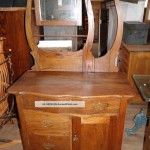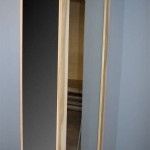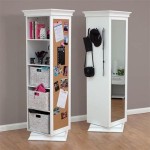How to Tell if a Mirror is Two-Sided
Two-sided mirrors, also known as one-way mirrors, are specialized pieces of glass that allow differential transmission of light depending on the relative lighting levels on either side. They create the illusion of reflection on one side while offering a view through the glass from the other, typically a darker, more concealed side. Determining if a mirror is genuinely two-sided requires careful observation and testing beyond simple visual inspection.
One of the most reliable methods for identifying a two-sided mirror is the "fingernail test." This involves placing the tip of a fingernail against the reflective surface of the mirror. With a standard, first-surface mirror, a distinct gap will be visible between the fingernail and its reflection due to the presence of a protective backing layer behind the reflective coating. However, with a two-sided mirror, the fingernail and its reflection will appear to touch due to the reflective coating being applied to the front surface of the glass. It's important to note that certain high-quality first-surface mirrors may also exhibit this characteristic, so the fingernail test alone is not definitive.
The surrounding lighting conditions play a crucial role in the functionality of two-sided mirrors. These mirrors operate under the principle of differential light transmission, meaning that the side with brighter lighting appears as a mirror while the darker side allows observation. Therefore, manipulating the lighting levels can help identify a two-sided mirror. If possible, significantly darken the room where the mirror is located and observe if visibility through the glass increases. Conversely, increasing the light level on the suspected observation side can also reveal its two-way nature.
Another method involves using a bright light source, such as a flashlight or a laser pointer. By shining the light directly onto the mirror's surface, one can observe the light's behavior. With a standard mirror, the majority of the light will be reflected back, while a two-sided mirror will allow a portion of the light to pass through. This transmitted light can be more easily observed in a darkened environment. Observe both the reflection and the area behind the suspected mirror for any signs of light transmission.
Sound transmission can also be an indicator. Two-sided mirrors, due to their thinner construction compared to standard mirrors with backing, may transmit sound more readily. If the environment permits, gently tapping or scratching the surface of the mirror and listening for the sound's characteristics can provide clues. A duller or more muted sound might indicate a standard mirror with backing, while a brighter, more resonant sound might suggest a thinner, two-sided mirror.
Observing the installation of the mirror can also offer valuable insights. Two-sided mirrors are often installed flush within a wall or partition, creating a seamless appearance. Look for any seams, gaps, or frames around the mirror. A standard mirror is typically installed with a frame or backing for support and protection, whereas a two-sided mirror requires a more concealed installation to maintain the illusion of a regular reflective surface.
A more invasive, but conclusive method involves carefully examining the edges of the mirror. If access to the edges is possible, look for signs of a second layer of glass or a thin film coating on the front surface. Two-sided mirrors have the reflective coating applied to the front surface of a single piece of glass, while standard mirrors have the reflective layer applied to the back surface of the glass, protected by a backing.
It's important to acknowledge limitations in some of these methods. For instance, some advanced mirror coatings or specialized glass types can exhibit characteristics similar to two-sided mirrors, even though they are not. Furthermore, certain variations in manufacturing techniques can make identification more challenging. If the situation warrants definitive confirmation, consulting with a glass expert or a professional security consultant is recommended. They possess the expertise and specialized equipment to unequivocally identify the mirror's properties.
Finally, awareness of the legal and ethical implications associated with two-sided mirrors is crucial. Their usage is restricted in many jurisdictions, particularly in contexts involving privacy concerns, such as restrooms or changing rooms. Suspected misuse of two-sided mirrors should be reported to the appropriate authorities.

How To Detect A Two Way Mirror Fingernail Test

How To Tell If A Mirror Is Two Way Or Not 8 Steps With Pictures

How To Tell If A Mirror Is Two Way Or Not 8 Steps With Pictures Hotel Mirrors Double Sided
How You Do A Quick Check For Cams Or Two Way Mirrors In Trial Rooms Quora

How To Tell If A Mirror Is Two Way Or Not 8 Steps With Pictures

How To Tell If A Mirror Is Two Way Or Not Quora

How To Tell If A Mirror Is Two Way Or Not 8 Steps With Pictures

Tips For Identifying Whether Your Mirror Is Two Way Or Not Ledmyplace

How To Tell If You Re In A Room Restroom Motel Etc With Mirror Or
How To Tell If A Mirror Is Two Way Or Not Quora








